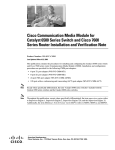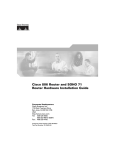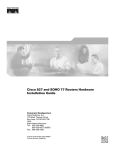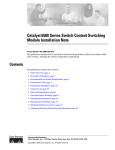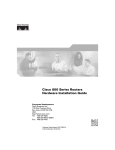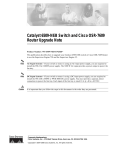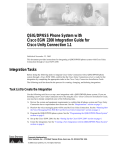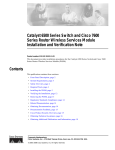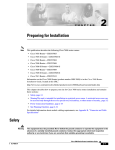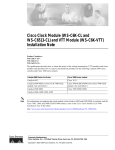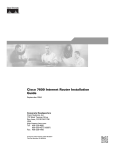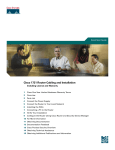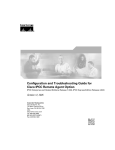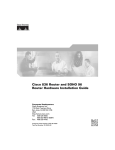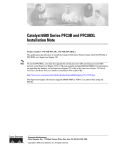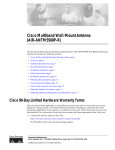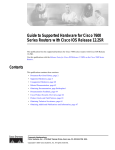Download Cisco Systems WS-SVC-CMM User's Manual
Transcript
Catalyst 6500 Series Switch and
Cisco 7600 Series Router CMM
Installation and Verification Note
Product Number: WS-SVC-CMM
This publication contains the procedures for installing and configuring the Catalyst 6500 series switch
and Cisco 7600 series router Communication Media Module (CMM). Installation and configuration
procedures are provided for the following CMM port adapters:
•
6-port T1 port adapter (WS-SVC-CMM-6T1)
•
6-port E1 port adapter (WS-SVC-CMM-6E1)
•
24-port FXS port adapter (WS-SVC-CMM-24FXS)
•
128-port ad-hoc conferencing and transcoding (ACT) port adapter (WS-SVC-CMM-ACT)
Note
Except where specifically differentiated, the term “Catalyst 6500 series switches” includes both Catalyst 6500
series switches and Catalyst 6000 series switches.
Note
Throughout this publication, except where specifically differentiated, the term supervisor engine refers
to Supervisor Engine 1, Supervisor Engine 2, and Supervisor Engine 720. Additionally, the term
Multilayer Switch Feature Card (MSFC) refers to MSFC, MSFC2, and MSFC3.
Corporate Headquarters:
Cisco Systems, Inc., 170 West Tasman Drive, San Jose, CA 95134-1706 USA
Copyright © 2001–2005 Cisco Systems, Inc. All rights reserved.
Contents
Contents
This publication contains these sections:
•
Front Panel Descriptions, page 2
•
Requirements, page 6
•
Safety Overview, page 7
•
Required Tools, page 9
•
Installing and Removing the CMM, page 9
•
Removing and Replacing Port Adapters, page 18
•
Verifying the Installation, page 24
•
RJ-45 Port Connector and Cabling Specifications, page 24
•
RJ-21 Port Connector and Cabling Specifications, page 26
•
Accessing the Port Adapter Ports, page 27
•
Configuring the Port Adapter Ports, page 28
•
Configuring the Port Adapter Clock Source, page 28
•
Disaster Recovery for CMM Software Upgrades, page 29
•
Regulatory Standards Compliance, page 31
•
Related Documentation, page 31
•
Obtaining Documentation, page 32
•
Documentation Feedback, page 33
•
Cisco Product Security Overview, page 33
•
Obtaining Technical Assistance, page 34
•
Obtaining Additional Publications and Information, page 35
Front Panel Descriptions
These sections describe the front panel features of the CMM and the port adapters:
•
CMM, page 2
•
6-Port T1 and E1 Port Adapters, page 4
•
24-Port FXS Port Adapter, page 5
•
Ad-Hoc Conferencing and Transcoding Port Adapter, page 5
CMM
The front panel features of the CMM are as follows:
•
STATUS LED—When the CMM powers up, it initializes various hardware components and
communicates with the supervisor engine. The STATUS LED shows the dialog with the supervisor
engine and the results of the initialization. During the normal initialization sequence, the STATUS
LED changes from off to red, to orange, and then to green. Table 1 describes the STATUS LED
operation.
Catalyst 6500 Series Switch and Cisco 7600 Series Router CMM Installation and Verification Note
2
78-14107-07
Front Panel Descriptions
Note
•
Port adapter slots—Figure 1 shows the E1 port adapter in the left and middle slots, with a blank filler
plate in the right slot.
•
REAR MODULE STATUS LED—Table 2 describes the REAR MODULE STATUS LED operation.
For information on the supervisor engine LEDs, refer to the Catalyst 6500 Series Switch Supervisor
Engine Guide at this URL:
http://www.cisco.com/univercd/cc/td/doc/product/lan/cat6000/6000hw/supe_gd/index.htm
Figure 1
CMM Front Panel Features
Interface Module slots
WS-SVC-CMM-6E1
1
2
3
4
5
0
1
2
3
4
5
ST
AT
US
0
Communication Media Module
6-Port E1 Interface Port Adapter.
6-Port E1 Interface Port Adapter.
STATUS LED
Table 1
Color
Off
68447
WS-SVC-CMM-6E1
RE
ST AR
AT M
US DL
WS-SVC-CMM
REAR MODULE STATUS LED
CMM STATUS LED
Description
•
The module is waiting for the supervisor engine to grant power.
•
The module is not online.
•
The module is not receiving power, which could be caused by the following:
– Power is not available to the module.
– Module temperature is over the limit1.
Red
Orange
Green
•
The module is released from reset by the supervisor engine and is booting.
•
If the boot code fails to execute, the LED stays red after power up.
•
The module is initializing hardware or communicating with the supervisor
engine.
•
A fault occurred during the initialization sequence.
•
If the module fails to download its Field Programmable Gate Arrays (FPGAs)
on startup, it continues initializing and is granted module online status from
the supervisor engine, but the LED stays orange.
•
If the module is not granted module online status from the supervisor engine,
the LED stays orange. This problem could be caused by the supervisor engine
detecting a failure in an external loopback test that it issued to the module.
•
The module is operational; the supervisor engine has granted module online
status.
1. Enter the show environment temperature mod command to display the temperature of each of the four sensors on the
module.
Catalyst 6500 Series Switch and Cisco 7600 Series Router CMM Installation and Verification Note
78-14107-07
3
Front Panel Descriptions
Table 2
CMM Rear Module STATUS LED
Color
Description
Green
Port adapter in slot 4 is up and operational.
Red
Port adapter in slot 4 is shut down.
No light
Slot 4 port adapter is not located by the system.
6-Port T1 and E1 Port Adapters
The front panel features of the 6-port T1 and E1 port adapters are as follows:
•
Receive port LEDs—The LEDs on the front panel indicate the status of each T1 and E1 interface.
Table 3 describes the receive port LED operation.
•
RJ-45 connectors—See the “RJ-45 Port Connector and Cabling Specifications” section on page 24
for details.
Figure 2 shows the front panels of the 6-port T1 and E1 port adapters.
Figure 2
6-Port T1 and E1 Port Adapter Front Panel Features
Receive port LEDs
Receive port LEDs
WS-SVC-CMM-6E1
1
2
3
4
5
0
68448
0
6-Port T1 Interface Port Adapter
2
3
4
6-Port E1 Interface Port Adapter
RJ-45 connectors
Table 3
1
5
68449
WS-SVC-CMM-6T1
RJ-45 connectors
6-Port T1 and E1 Port Adapters Receive Port LEDs
Color
Description
Green
T1/E1 interface is operational.
Red
T1/E1 receive alarm.
Yellow
T1/E1 remote alarm.
Off
T1/E1 interface has been administratively shut down, or there is no
power.
Catalyst 6500 Series Switch and Cisco 7600 Series Router CMM Installation and Verification Note
4
78-14107-07
Front Panel Descriptions
24-Port FXS Port Adapter
The front panel features of the 24-port FXS port adapter are as follows:
Warning
•
Receive port LEDs—The LEDs on the front panel indicate the status of each FXS interface. Table 4
describes the receive port LED operation.
•
RJ-21 connector—See the “RJ-21 Port Connector and Cabling Specifications” section on page 26
for details.
If the symbol of suitability with an overlaid cross appears above a port, you must not connect the
port to a public network that follows the European Union standards. Connecting the port to this type
of public network can cause severe personal injury or can damage the unit. Statement 1031
Figure 3 shows the front panel of the 24-port FXS port adapter.
Figure 3
24-Port FXS Port Adapter Front Panel Features
Receive port LEDs
98289
WS-SVC-CMM-24FXS
FXS Interface Board Adapter
RJ-21 connector
Table 4
24-Port FXS Port Adapter Receive Port LEDs
Color
Description
Green
Port is off-hook or ringing.
Off
Port is not active (connected device on-hook) or is disabled through
the CLI.
Ad-Hoc Conferencing and Transcoding Port Adapter
The front panel features of the ad-hoc conferencing and transcoding port adapter are shown in Figure 4,
and the STATUS LED is described in Table 5.
Catalyst 6500 Series Switch and Cisco 7600 Series Router CMM Installation and Verification Note
78-14107-07
5
Requirements
Figure 4
Ad-hoc Conferencing and Transcoding Port Adapter Front Panel Features
Ad-hoc Conferencing and Transcoding Port Adapter
Table 5
99302
WS-SVC-CMM-ACT
Ad-hoc Conferencing and Transcoding Port Adapter STATUS LED
Color
Description
Green
Port adapter is up and operational.
Red
Port adapter is shut down.
Off
Port adapter is not located by the system.
Requirements
These sections describe the hardware and software requirements:
•
Hardware Requirements, page 6
•
Software Requirements, page 7
Hardware Requirements
The hardware requirements for the CMM are as follows:
•
Catalyst 6500 series switch.
•
Cisco 7600 series router.
•
A Supervisor Engine 1, Supervisor Engine 2, or Supervisor Engine 720—The supervisor engine can have
an MSFC, MSFC2, or MSFC3, but the CMM does not require one for configuration or operation.
•
Port adapters—You can install up to three T1, E1, or FXS port adapters into slots 1 through 3 on the
CMM base module.
You can install up to four ACT port adapters into the CMM base module. (The internally located
slot 4 is reserved for the ACT port adapter.)
Note
•
You cannot mix T1 port adapters with E1 port adapters, but any other combination of port
adapters is supported.
CMM module blank filler plate (WS-SVC-CMM-BLANK) for unused port adapter slots.
Catalyst 6500 Series Switch and Cisco 7600 Series Router CMM Installation and Verification Note
6
78-14107-07
Safety Overview
Software Requirements
For software requirements, refer to the Release Notes for the Cisco Catalyst 6500 Series and the Cisco
7600 Series Communication Media Module at this URL:
http://www.cisco.com/univercd/cc/td/doc/product/lan/cat6000/mod_icn/cmm/index.htm
Safety Overview
Throughout this publication, safety warnings appear in procedures that, if performed incorrectly, can
harm you. A warning symbol precedes each warning statement.
Warning
IMPORTANT SAFETY INSTRUCTIONS
This warning symbol means danger. You are in a situation that could cause bodily injury. Before you
work on any equipment, be aware of the hazards involved with electrical circuitry and be familiar
with standard practices for preventing accidents. Use the statement number provided at the end of
each warning to locate its translation in the translated safety warnings that accompanied this
device. Statement 1071
SAVE THESE INSTRUCTIONS
Warning
Ultimate disposal of this product should be handled according to all national laws and regulations.
Statement 1040
Warning
Only trained and qualified personnel should be allowed to install, replace, or service this equipment.
Statement 1030
Warning
If the symbol of suitability with an overlaid cross appears above a port, you must not connect the
port to a public network that follows the European Union standards. Connecting the port to this type
of public network can cause severe personal injury or can damage the unit. Statement 1031
Warning
During this procedure, wear grounding wrist straps to avoid ESD damage to the card. Do not directly
touch the backplane with your hand or any metal tool, or you could shock yourself. Statement 94
Warning
Invisible laser radiation may be emitted from disconnected fibers or connectors. Do not stare into
beams or view directly with optical instruments. Statement 1051
Catalyst 6500 Series Switch and Cisco 7600 Series Router CMM Installation and Verification Note
78-14107-07
7
Safety Overview
Warning
Blank faceplates and cover panels serve three important functions: they prevent exposure to
hazardous voltages and currents inside the chassis; they contain electromagnetic interference (EMI)
that might disrupt other equipment; and they direct the flow of cooling air through the chassis. Do not
operate the system unless all cards, faceplates, front covers, and rear covers are in place.
Statement 1029
Warning
Hazardous voltage or energy is present on the backplane when the system is operating. Use caution
when servicing. Statement 1034
Warning
Before opening the unit, disconnect the telephone-network cables to avoid contact with
telephone-network voltages. Statement 1041
Warning
Do not work on the system or connect or disconnect cables during periods of lightning activity.
Statement 1001
Warning
Never install telephone jacks in wet locations unless the jack is specifically designed for
wet locations. Statement 1036
Warning
Never touch uninsulated telephone wires or terminals unless the telephone line has been
disconnected at the network interface. Statement 1037
Warning
Hazardous network voltages are present in WAN ports regardless of whether power to the unit is OFF
or ON. To avoid electric shock, use caution when working near WAN ports. When detaching cables,
detach the end away from the unit first. Statement 1026
Warning
To avoid electric shock, do not connect safety extra-low voltage (SELV) circuits to telephone-network
voltage (TNV) circuits. LAN ports contain SELV circuits, and WAN ports contain TNV circuits. Some
LAN and WAN ports both use RJ-45 connectors. Use caution when connecting cables. Statement 1021
Warning
To reduce the risk of fire, use only No. 26 AWG or larger telecommunication line cord. Statement 1023
Catalyst 6500 Series Switch and Cisco 7600 Series Router CMM Installation and Verification Note
8
78-14107-07
Required Tools
Required Tools
Warning
Only trained and qualified personnel should be allowed to install, replace, or service this equipment.
Statement 1030
These tools are required to remove and replace the CMM and port adapters:
•
Flat-blade screwdriver (for CMM)
•
Number 1 Phillips screwdriver (for the screws and standoffs)
•
Antistatic mat or foam pad
•
Your own ESD-prevention equipment or the disposable grounding wrist strap that is included with
all upgrade kits, field-replaceable units (FRUs), and spares
Whenever you handle a module, always use a wrist strap or other grounding device to prevent
electrostatic discharge (ESD). For information on preventing ESD, refer to the “Preventing ESD” section
of the Regulatory Compliance and Safety Information publication.
Installing and Removing the CMM
This section describes the procedures for installing and removing the CMM:
•
Installing the CMM, page 9
•
Removing the CMM, page 16
Installing the CMM
This section describes how to install the CMM into the Catalyst 6500 series switch or the Cisco 7600
series router.
Note
All modules, including the supervisor engine (if you have redundant supervisor engines), support hot
swapping. You can add, replace, or remove modules without interrupting the system power or causing
other software or interfaces to shut down. For more information about hot-swapping modules, refer to
the Catalyst 6500 Series Switch Module Installation Guide.
Warning
During this procedure, wear grounding wrist straps to avoid ESD damage to the card. Do not directly
touch the backplane with your hand or any metal tool, or you could shock yourself. Statement 94
Catalyst 6500 Series Switch and Cisco 7600 Series Router CMM Installation and Verification Note
78-14107-07
9
Installing and Removing the CMM
To install the CMM into the Catalyst 6500 series switch or the Cisco 7600 series router, perform these
steps:
Step 1
Make sure that you take the necessary precautions to prevent ESD damage.
Step 2
Choose a slot for the CMM.
Step 3
Verify that there is enough clearance to accommodate any interface equipment that you will connect
directly to the module ports. If possible, place modules between empty slots that contain only module
filler plates.
Step 4
Verify that the captive installation screws are tightened on all modules that are installed in the chassis.
This action ensures that the EMI gaskets on all modules are fully compressed to maximize the opening
space for the replacement module.
Note
If the captive installation screws are loose, the EMI gaskets on the installed modules will push
adjacent modules toward the open slot, reducing the opening size and making it difficult to
install the replacement module.
Step 5
Remove the module filler plate by removing the two Phillips pan-head screws from the filler plate. (To
remove a module, refer to the “Removing the CMM” section on page 16.)
Step 6
Fully open both ejector levers on the new or replacement module. (See Figure 5.)
Step 7
Depending on the orientation of the slots in the chassis (horizontal or vertical), perform one of the
following sets of substeps:
Horizontal slots
a.
Position the module in the slot. Make sure that you align the sides of the module carrier with the slot
guides on each side of the slot. (See Figure 5.)
a.
Carefully slide the module into the slot until the EMI gasket along the top edge of the module makes
contact with the module in the slot above it and both ejector levers have closed to approximately
45 degrees with respect to the module faceplate. (See Figure 6.)
Catalyst 6500 Series Switch and Cisco 7600 Series Router CMM Installation and Verification Note
10
78-14107-07
Installing and Removing the CMM
Figure 5
Positioning the Module in a Horizontal Slot Chassis
Insert module
between slot guides
EMI gasket
3
4
5
6
4
5
6
WS-X6K-SUP2-2GE
1
T
E
US
NS
ST
SY
GM
OL
EM
AT
ST
R
CO
M
Switch
100%
T
SE
PW
Load
CONSOLE
PORT
MODE
RE
PORT 1
PORT 2
CONSOLE
SUPERVISOR2
PCMCIA
EJECT
1%
WS-X6K-SUP2-2GE
2
T
E
US
NS
ST
SY
GM
OL
EM
AT
ST
CO
R
PW
M
Switch
100%
T
SE
Load
CONSOLE
PORT
MODE
RE
PORT 1
PORT 2
CONSOLE
SUPERVISOR2
PCMCIA
EJECT
1%
3
4
FAN
STATUS 5
6
WS-X6224
US
VE
AT
TI
AC
SE
LE
24 PORT 100FX
NE
EMI gasket
CT
XT
58569
ST
o
o
INPUT
OK
FAN
OK
OUTPUT
FAIL
INPUT
OK
FAN
OK
OUTPUT
FAIL
WS-C6500-SFM
US
AT
ST
E
TIV
AC
SWITCH FABRIC MDL
Ejector lever fully
extended
Catalyst 6500 Series Switch and Cisco 7600 Series Router CMM Installation and Verification Note
78-14107-07
11
Installing and Removing the CMM
Figure 6
Clearing the EMI Gasket in a Horizontal Slot Chassis
WS-X6K-SUP2-2GE
1
US
AT
ST
LE
EM
ST
SY
O
NS
CO
PW
M
R
G
M
T
Switch
100%
T
SE
RE
CONSOLE
Load
CONSOLE
PORT
MODE
SUPERVISOR2
PORT 1
PCMCIA
PORT 2
EJECT
1%
WS-X6K-SUP2-2GE
NK
LI
2
US
AT
ST
LE
EM
ST
SY
O
NS
CO
PW
M
R
G
M
Switch
100%
T
SE
RE
CONSOLE
SUPERVISOR2
NK
LI
T
CONSOLE
PORT
MODE
Load
PORT 1
PCMCIA
PORT 2
EJECT
1%
NK
LI
NK
LI
3
Press down
4
FAN
STATUS 5
Press down
WS-X6224
S
TU
VE
TI
STA
AC
CT
LE
SE
24 PORT 100FX
XT
NE
6
3
4
WS-C6500-SFM
5
5
US
AT
SWITCH FABIR
ST
D MDL
6
b.
Caution
E
TIV
AC
1 mm Gap between the module
EMI gasket and the
module above it
6
58570
4
Using the thumb and forefinger of each hand, grasp the two ejector levers and press down to create
a small (0.040 inch [1 mm]) gap between the EMI gasket and the module above it. (See Figure 6.)
Pressing down too firmly on the levers will bend and damage them.
c.
While pressing down, simultaneously close the left and right ejector levers to fully seat the module
in the backplane connector. The ejector levers are fully closed when they are flush with the module
faceplate. (See Figure 7.)
Catalyst 6500 Series Switch and Cisco 7600 Series Router CMM Installation and Verification Note
12
78-14107-07
Installing and Removing the CMM
Figure 7
Ejector Lever Closure in a Horizontal Slot Chassis
WS-X6K-SUP2-2GE
1
US
AT
ST
LE
EM
ST
SY
O
NS
CO
PW
R
M
G
M
T
Switch
100%
T
SE
RE
CONSOLE
SUPERVISOR2
Load
CONSOLE
PORT
MODE
PORT 1
PCMCIA
PORT 2
EJECT
1%
WS-X6K-SUP2-2GE
NK
LI
2
US
AT
ST
EM
ST
SY
M
G
O
NS
R
CO
NK
LI
T
LE
PW
M
Switch
100%
T
SE
RE
CONSOLE
SUPERVISOR2
Load
CONSOLE
PORT
MODE
PORT 1
PCMCIA
PORT 2
EJECT
1%
NK
LI
NK
LI
3
4
FAN
STATUS 5
WS-C6500-SFM
S
TU
STA
CT
VE
TI
AC
LE
SE
SWITCH FABRIC MDL
XT
NE
58571
6
Ejector levers flush
with module faceplate
Note
d.
Note
Failure to fully seat the module in the backplane connector can result in error messages.
Tighten the two captive installation screws on the module.
Make sure that the ejector levers are fully closed before tightening the captive installation
screws.
Vertical slots
a.
Position the module in the slot. (See Figure 8.) Make sure that you align the sides of the module
carrier with the slot guides on the top and bottom of the slot.
Catalyst 6500 Series Switch and Cisco 7600 Series Router CMM Installation and Verification Note
78-14107-07
13
Installing and Removing the CMM
Figure 8
Positioning the Module in a Vertical Slot Chassis
Ejector lever fully
extended
WS-C6500-SFM
SWITCH FABRIC MDL
FAN
STATUS
WS-X6K-SUP2-2GE
MT
E
M
S
OL
T
MG
TU
R
NS
SE
STE
RE
PW
CO
SY
STA
MT
OLE MG
TEM NS
TUS
R
SET
RE
PW
SYS
CO
STA
WS-X6K-SUP2-2GE
SUPERVISOR2
SUPERVISOR2
ST
AT
CONSOLE
CONSOLE
US
AC
PORT
MODE
PORT
MODE
CONSOLE
WS-X6224
24 PORT 100FX
CONSOLE
TIV
E
US
AT
ST
E
TIV
AC
PCMCIA
PCMCIA
EJECT
EJECT
Switch
Switch
1%
100%
1%
100%
Load
Load
EMI
gasket
PORT 1
PORT 1
PORT 2
PORT 2
CT
LE
XT
SE
NE
63585
EMI
gasket
o
o
INPUT
OK
FAN
OK
OUTPUT
FAIL
INPUT
OK
FAN
OK
OUTPUT
FAIL
6
Insert module
between slot guides
3
4
b.
Carefully slide the module into the slot until the EMI gasket along the right edge of the module
makes contact with the module in the slot adjacent to it and both ejector levers have closed to
approximately 45 degrees with respect to the module faceplate. (See Figure 9.)
c.
Using the thumb and forefinger of each hand, grasp the two ejector levers and exert a slight pressure
to the left, deflecting the module approximately 0.040 inches (1 mm) to create a small gap between
the module’s EMI gasket and the module adjacent to it. (See Figure 9.)
Catalyst 6500 Series Switch and Cisco 7600 Series Router CMM Installation and Verification Note
14
78-14107-07
Installing and Removing the CMM
Figure 9
Clearing the EMI Gasket in a Vertical Slot Chassis
Gap between the module
EMI gasket and the
module above it
1 mm
WS-C6500-SFM
SWITCH FABIRD MDL
S
TU
A
ST
E
TIV
AC
FAN
STATUS
WS-X6K-SUP2-2GE
MT
E
M
S
OL
T
MG
TU
R
NS
SE
STE
RE
PW
CO
SY
STA
US
AT
ST
MT
OLE MG
TEM NS
TUS
R
SET
RE
PW
SYS
CO
STA
WS-X6K-SUP2-2GE
SUPERVISOR2
SUPERVISOR2
WS-X6224
24 PORT 100FX
CONSOLE
CONSOLE
E
TIV
AC
PORT
MODE
PORT
MODE
CONSOLE
CONSOLE
Press left
PCMCIA
PCMCIA
EJECT
EJECT
Switch
Switch
1%
100%
1%
100%
Load
Load
PORT 1
PORT 1
CT
LE
SE
XT
NE
Press left
63586
PORT 2
PORT 2
o
o
INPUT
OK
FAN
OK
OUTPUT
FAIL
INPUT
OK
Caution
FAN
OK
OUTPUT
FAIL
Exerting too much pressure on the ejector levers will bend and damage them.
d.
While pressing on the ejector levers, simultaneously close them to fully seat the module in the
backplane connector. The ejector levers are fully closed when they are flush with the module
faceplate. (See Figure 10.)
Catalyst 6500 Series Switch and Cisco 7600 Series Router CMM Installation and Verification Note
78-14107-07
15
Installing and Removing the CMM
Figure 10
Ejector Lever Closure in a Vertical Slot Chassis
FAN
STATUS
T
M
LE
G
O
T
M
EM
US
R
NS
SE
ST
AT
RE
PW
SY
CO
ST
CO
EM
ST
SY
O
NS
PW
LE
STA
R
T
CONSOLE
CONSOLE
VE
TI
AC
SE
T
M
RE
G
S
M
TU
CONSOLE
PORT
MODE
CONSOLE
PORT
MODE
PCMCIA
PCMCIA
EJECT
EJECT
1%
Switch
Switch
100%
1%
100%
Load
Load
PORT 1
PORT 1
XT
WS-X6K-SUP2-2GE
SUPERVISOR2
US
AT
ST
WS-X6K-SUP2-2GE
SUPERVISOR2
WS-X6224
24 PORT 100FX
NE
SE
LE
CT
63587
PORT 2
PORT 2
All ejector levers flush
with module faceplate
e.
Note
Tighten the two captive installation screws on the module.
Make sure that the ejector levers are fully closed before tightening the captive installation
screws.
This completes the CMM installation procedure.
Removing the CMM
This section describes how to remove the CMM from a Catalyst 6500 series switch or the Cisco 7600
series router.
Caution
Warning
During this procedure, wear grounding wrist straps to avoid ESD damage to the module. Do not directly
touch the backplane with your hand or any metal tool, or you could shock yourself.
Invisible laser radiation may be emitted from disconnected fibers or connectors. Do not stare into
beams or view directly with optical instruments. Statement 1051
Catalyst 6500 Series Switch and Cisco 7600 Series Router CMM Installation and Verification Note
16
78-14107-07
Installing and Removing the CMM
To remove a module from the chassis, perform these steps:
Step 1
Disconnect any network interface cables that are attached to the module.
Step 2
Verify that the captive installation screws on all of the modules in the chassis are tight.
This step assures that the space that is created by the removed module is maintained.
Note
If the captive installation screws are loose, the electromagnetic interference (EMI) gaskets on
the installed modules will push the modules toward the open slot, reducing the opening size and
making it difficult to install the replacement module.
Step 3
Loosen the two captive installation screws on the module.
Step 4
Depending on the orientation of the slots in the chassis (horizontal or vertical), perform one of the
following sets of substeps:
Horizontal slots
a.
Place your thumbs on the left and right ejector levers, and simultaneously rotate the levers outward
to unseat the module from the backplane connector.
b.
Grasp the front edge of the module, and slide the module part of the way out of the slot. Place your
other hand under the module to support the weight of the module. Do not touch the module
circuitry.
Vertical slots
a.
Place your thumbs on the ejector levers that are located at the top and bottom of the module, and
simultaneously rotate the levers outward to unseat the module from the backplane connector.
b.
Grasp the edges of the module, and slide the module straight out of the slot. Do not touch the
module circuitry.
Step 5
Place the module on an antistatic mat or antistatic foam, or immediately reinstall it in another slot.
Step 6
If the slot from which you removed the module is to remain empty, install a module filler plate to keep
dust out of the chassis and to maintain proper airflow through the chassis.
Warning
Blank faceplates and cover panels serve three important functions: they prevent exposure to
hazardous voltages and currents inside the chassis; they contain electromagnetic interference (EMI)
that might disrupt other equipment; and they direct the flow of cooling air through the chassis. Do not
operate the system unless all cards, faceplates, front covers, and rear covers are in place.
Statement 1029
Catalyst 6500 Series Switch and Cisco 7600 Series Router CMM Installation and Verification Note
78-14107-07
17
Removing and Replacing Port Adapters
Removing and Replacing Port Adapters
Follow the procedures in this section to remove and replace the port adapters on the CMM:
•
Removing a Port Adapter from CMM Slots 1 through 3, page 18
•
Installing a Port Adapter in CMM Slots 1 through 3, page 21
•
Installing and Removing an Ad-Hoc Conferencing and Transcoding Port Adapter in Slot 4, page 22
Removing a Port Adapter from CMM Slots 1 through 3
Note
When you face the CMM front panel, slot 1 is on the left, slot 2 is in the middle, and slot 3 is on the
right. Slot 4 is located internally. (See Figure 13.)
To remove a port adapter, perform these steps:
Warning
Hazardous voltage or energy is present on the backplane when the system is operating. Use caution
when servicing. Statement 1034
Step 1
Remove the CMM from the Catalyst 6500 series switch or the Cisco 7600 series router; see the
“Removing the CMM” section on page 16.
Step 2
Carefully place the CMM, component-side down, on an antistatic mat or foam pad, with the front of the
CMM facing toward you. (See Figure 11.)
Step 3
Remove the two Phillips screws securing the port adapter. (See Figure 11.)
Step 4
Carefully turn the CMM component-side up and place it on the antistatic mat or foam pad.
Step 5
Remove the two standoffs and the two remaining Phillips screws securing the port adapter. (See
Figure 12.)
Step 6
Note the location of the two connectors in Figure 13 and remove the port adapter, taking care when
lifting up and disconnecting the port adapter from the connectors.
Tip
To unseat the port adapter from the two connectors, grasp the rear of the port adapter with one hand, and
gently but firmly pull up on the rear of the port adapter until it is free of the connectors.
Step 7
Place the removed port adapter in an antistatic bag.
Step 8
If leaving an empty slot, install a blank filler plate.
Catalyst 6500 Series Switch and Cisco 7600 Series Router CMM Installation and Verification Note
18
78-14107-07
Removing and Replacing Port Adapters
To install the CMM into the Catalyst 6500 series switch or the Cisco 7600 series router, see the
“Installing the CMM” section on page 9.
6Port EI Intfc Mdl
6Port TI Intfc Mdl
S
U
TA
T
S
1
2
3
4
5
6
WS-X6600-6EI
1
2
3
4
5
6
R
S EA
TA R
T
U MD
S
L
68446
CMM (Bottom View)
WS-X6600-6TI
Figure 11
WS-X6600
Step 9
Blank faceplates and cover panels serve three important functions: they prevent exposure to
hazardous voltages and currents inside the chassis; they contain electromagnetic interference (EMI)
that might disrupt other equipment; and they direct the flow of cooling air through the chassis. Do not
operate the system unless all cards, faceplates, front covers, and rear covers are in place.
Statement 1029
AVVID Services Module
Warning
Phillips screws (6)
(installed from bottom)
Catalyst 6500 Series Switch and Cisco 7600 Series Router CMM Installation and Verification Note
78-14107-07
19
Removing and Replacing Port Adapters
Figure 12
CMM (Top View with Port Adapters Installed)
Slot 4
standoffs (2)
Slot 4 Phillips
screws (2)
Standoffs (6)
1
2
3
4
5
6
WS-X6600-6EI
1
2
3
4
5
6
S
TA
T
U
S
WS-X6600-6TI
R
S EA
TA R
T
U MD
S
L
WS-X6600
AVVID Services Module
Figure 13
6Port TI Intfc Mdl
6Port EI Intfc Mdl
68453
Phillips
screws (6)
CMM (Top View with Port Adapters Removed)
Slot 4 connectors (2)
Slot 4 Phillips
screw mounting
posts (2)
Slot 4 standoff
mounting
posts (2)
Standoff mounting
posts (6)
Port adapter
connectors (6)
Slot 1
Slot 2
Phillips screw
access holes (6)
Slot 3
68452
Phillips screw
mounting posts (6)
Catalyst 6500 Series Switch and Cisco 7600 Series Router CMM Installation and Verification Note
20
78-14107-07
Removing and Replacing Port Adapters
Installing a Port Adapter in CMM Slots 1 through 3
Note
When you face the CMM front panel, slot 1 is on the left, slot 2 is in the middle, and slot 3 is on the
right. Slot 4 is located internally. (See Figure 13.)
To install a port adapter in CMM slots 1 through 3, perform these steps:
Warning
Hazardous voltage or energy is present on the backplane when the system is operating. Use caution
when servicing. Statement 1034
Step 1
Remove the CMM from the Catalyst 6500 series switch or the Cisco 7600 series router; see the
“Removing the CMM” section on page 16.
Step 2
Carefully place the CMM, component-side up, on an antistatic mat or foam pad, with the front of the
CMM facing toward you.
Step 3
If there is a blank filler plate installed, remove it.
Step 4
Remove the new port adapter from its antistatic bag.
Step 5
Locate the slot in which you are going to install the port adapter. Note the location of the following items
(see Figure 13):
•
Two port adapter connectors
•
Two standoff mounting posts
•
Two Phillips screw mounting posts
•
Two Phillips screw access holes
Step 6
Align the port adapter with the mounting posts and mounting holes. Ensure that the connectors on the
port adapter are aligned with the connectors on the CMM.
Step 7
When all mounting posts and mounting holes are aligned, gently push down on the port adapter edges
to ensure that the keys on the connectors are properly aligned. If necessary, while applying pressure with
your left hand, rock the module up and down slightly with your right hand to seat the port adapter.
Tip
To seat the port adapter into the two connectors, grasp the rear of the port adapter with one hand, and
gently but firmly push down on the rear of the port adapter until it is seated in the connectors. You will
hear a distinctive “click” when the port adapter seats in the connectors.
Caution
Use care not to damage the connectors on the port adapter. If you damage a connector, you will have to
return the port adapter to Cisco for repair.
Catalyst 6500 Series Switch and Cisco 7600 Series Router CMM Installation and Verification Note
78-14107-07
21
Removing and Replacing Port Adapters
Caution
Using the screws or standoffs to seat the port adapter could warp the port adapter. Before you install and
tighten the securing screws, ensure that the port adapter is fully seated by visually verifying that the
bottom of the port adapter is in contact with the top of the mounting posts.
Step 8
Install the two standoffs and two Phillips screws to secure the port adapter. (See Figure 12.)
Step 9
Carefully turn the CMM component-side down, and place it on the antistatic mat or foam pad.
Step 10
Install the two remaining Phillips screws. (See Figure 11.)
Step 11
Install the CMM into the Catalyst 6500 series switch or the Cisco 7600 series router; see the “Installing
the CMM” section on page 9.
Installing and Removing an Ad-Hoc Conferencing and Transcoding Port
Adapter in Slot 4
Note
The ad-hoc conferencing and transcoding port adapter is the only port adapter that can be installed in
slot 4. Slot 4 is located internally. (See Figure 13.)
Warning
Hazardous voltage or energy is present on the backplane when the system is operating. Use caution
when servicing. Statement 1034
Follow these procedures to remove and install an ad-hoc conferencing and transcoding port adapter in
slot 4:
•
Removing an Ad-hoc Conferencing and Transcoding Port Adapter in Slot 4, page 22
•
Installing an Ad-Hoc Conferencing and Transcoding Port Adapter in Slot 4, page 23
Removing an Ad-hoc Conferencing and Transcoding Port Adapter in Slot 4
To remove a port adapter in CMM slot 4, perform these steps:
Step 1
Remove the CMM from the Catalyst 6500 series switch or Cisco 7600 series router; see the “Removing
the CMM” section on page 16.
Step 2
Carefully place the CMM, component side up, on an antistatic mat or foam pad, with the front of the
CMM facing toward you.
Step 3
In Figure 13, note the location of the two slot 4 Phillips screw mounting posts. Remove the two Phillips
screws that secure the right-hand side of the port adapter.
Catalyst 6500 Series Switch and Cisco 7600 Series Router CMM Installation and Verification Note
22
78-14107-07
Removing and Replacing Port Adapters
Step 4
In Figure 13, note the location of the two slot 4 standoff mounting posts. Remove the two mounting posts
that secure the port adapter.
Step 5
In Figure 13, note the location of the two slot 4 connectors. Carefully remove the port adapter, taking
care when lifting up and disconnecting the port adapter from the connectors.
Tip
To unseat the port adapter from the two connectors, grasp the left-hand side of the port adapter with one
hand, and gently but firmly pull up on the port adapter until it is free of the connectors.
Step 6
Place the removed port adapter in an antistatic bag.
Step 7
Install the CMM into the Catalyst 6500 series switch or the Cisco 7600 series router; see the “Installing
the CMM” section on page 9.
Installing an Ad-Hoc Conferencing and Transcoding Port Adapter in Slot 4
To install a port adapter in CMM slot 4, perform these steps:
Note
To install a port adapter in CMM slot 4, you need to remove the face plate from the port adapter. To
remove the face plate, position the port adapter with the face plate facing toward you, turn the port
adapter component side down on an antistatic mat or foam pad, and then remove the two Phillips screws
that secure the face plate.
Step 1
Remove the CMM from the Catalyst 6500 series switch or the Cisco 7600 series router; see the
“Removing the CMM” section on page 16.
Step 2
Carefully place the CMM, component side up, on an antistatic mat or foam pad, with the front of the
CMM facing toward you.
Step 3
In Figure 13, note the location of the two, slot-4 Phillips screw mounting posts, and note the location of
the two, slot-4 standoff mounting posts.
Step 4
Align the port adapter with the two slot 4 Phillips screw mounting posts and two slot 4 standoff mounting
posts. Ensure that the connectors on the port adapter are aligned with the connectors on the CMM.
Step 5
When all mounting posts and mounting holes are aligned, gently push down on the port adapter edges
that ensure that the keys on the connectors are properly aligned. If necessary, while applying pressure
with your left hand, rock the module up and down slightly with your right hand to seat the port adapter.
Tip
Caution
To seat the port adapter into the two connectors, grasp the left-hand side of the port adapter with one
hand, and gently but firmly push down on the left-hand side of the port adapter until it is seated in the
connectors. You will hear a distinctive “click” when the port adapter seats in the connectors.
Use care not to damage the connectors on the port adapter. If you damage a connector, you will have to
return the port adapter to Cisco for repair.
Catalyst 6500 Series Switch and Cisco 7600 Series Router CMM Installation and Verification Note
78-14107-07
23
Verifying the Installation
Caution
Using the screws or standoffs to seat the port adapter could warp the port adapter. Before you install and
tighten the securing screws, ensure that the port adapter is fully seated by visually verifying that the
bottom of the port adapter is in contact with the top of the mounting posts.
Step 6
Install the two standoffs and two Phillips screws to secure the port adapter. (See Figure 12.)
Step 7
Install the CMM into the Catalyst 6500 series switch or Cisco 7600 series router; see the “Installing the
CMM” section on page 9.
Verifying the Installation
Enter the show module mod-num command to verify that the system acknowledges the new CMM and
has brought it online.
This example shows the output of the show module command with a CMM in slot 4:
Console>
Mod Slot
--- ---4
4
(enable) show module 4
Ports Module-Type
Model
Sub Status
----- ------------------------- ------------------- --- -------5
Communication Media Mod. WS-SVC-CMM
no ok
Mod Module-Name
Serial-Num
--- -------------------- ----------4
sad054206jc
Mod MAC-Address(es)
Hw
Fw
Sw
--- -------------------------------------- ------ ---------- ----------------4
00-01-64-46-6a-0e to 00-01-64-46-6a-17 1.0
12.2(2002012.2(20020530:100440
RJ-45 Port Connector and Cabling Specifications
Warning
Before opening the unit, disconnect the telephone-network cables to avoid contact with
telephone-network voltages. Statement 1041
Warning
Do not work on the system or connect or disconnect cables during periods of lightning activity.
Statement 1001
Warning
Never install telephone jacks in wet locations unless the jack is specifically designed for
wet locations. Statement 1036
Warning
Never touch uninsulated telephone wires or terminals unless the telephone line has been
disconnected at the network interface. Statement 1037
Catalyst 6500 Series Switch and Cisco 7600 Series Router CMM Installation and Verification Note
24
78-14107-07
RJ-45 Port Connector and Cabling Specifications
Warning
Hazardous network voltages are present in WAN ports regardless of whether power to the unit is OFF
or ON. To avoid electric shock, use caution when working near WAN ports. When detaching cables,
detach the end away from the unit first. Statement 1026
Warning
To avoid electric shock, do not connect safety extra-low voltage (SELV) circuits to telephone-network
voltage (TNV) circuits. LAN ports contain SELV circuits, and WAN ports contain TNV circuits. Some
LAN and WAN ports both use RJ-45 connectors. Use caution when connecting cables. Statement 1021
Warning
To reduce the risk of fire, use only No. 26 AWG or larger telecommunication line cord. Statement 1023
The T1 and E1 port adapter RJ-45 port connector and cabling specifications are described in this section:
•
Figure 14 shows the RJ-45 port cable connector pin orientation.
•
Table 6 describes the RJ-45 port pinouts.
Figure 14
RJ-45 Port Connector
H1567a
RJ-45 (both ends)
Pin 1
Pin 8
Table 6
6-Port T1 and E1 Port Adapter RJ-45 Port Pinouts
Pin1
Description
1
Receive R1
2
Receive T1
3
Not connected
4
Transmit R
5
Transmit T
6
Not connected
7
Not connected
8
Not connected
1. Table 6 lists the pinouts for the RJ-45 port connector, not the pinouts of the cable connecting to the port.
Catalyst 6500 Series Switch and Cisco 7600 Series Router CMM Installation and Verification Note
78-14107-07
25
RJ-21 Port Connector and Cabling Specifications
RJ-21 Port Connector and Cabling Specifications
Warning
Caution
If the symbol of suitability with an overlaid cross appears above a port, you must not connect the
port to a public network that follows the European Union standards. Connecting the port to this type
of public network can cause severe personal injury or can damage the unit. Statement 1031
Do not connect the WS-SVC-CMM-24 FXS port adapter directly to a voicemail server, IVR application,
or fax server if the servers have unused wiring pairs with voltage on them. We recommend that you
connect the 25-pair cables to punch-down blocks and cross connect to the voicemail, IVR, or fax servers.
If you do not use punch-down blocks and cross connects to the WS-SVC-CMM-24 FXS port adapter,
you could damage the port adapter. For example, the FLT-8 card for the Octel 250 uses every other pair
for its voice ports. The unused pairs have +36 VDC across ring-to-ground in an on-hook condition, and
this high voltage has been known to damage the WS-SVC-CMM-24 FXS port adapter.
Use a standard RJ-21 Category 5 telco connector and cable to connect to the RJ-21 connector. Two types
of RJ-21 connectors are shown in Figure 15 and Figure 16. A pinout for the module’s RJ-21 connector
is provided in Table 7.
RJ-21 Telco Interface 90-Degree Cable Connector
Figure 16
RJ-21 Telco Interface 180-Degree Cable Connector
11486
11485
Figure 15
Catalyst 6500 Series Switch and Cisco 7600 Series Router CMM Installation and Verification Note
26
78-14107-07
Accessing the Port Adapter Ports
Table 7
RJ-21 Connector Pinouts
Port
Number
Connector Pin
Number
Signal
Port
Number
Connector Pin
Number
Signal
1
1
26
Ring
Tip
13
13
38
Ring
Tip
2
2
27
Ring
Tip
14
14
39
Ring
Tip
3
3
28
Ring
Tip
15
15
40
Ring
Tip
4
4
29
Ring
Tip
16
16
41
Ring
Tip
5
5
30
Ring
Tip
17
17
42
Ring
Tip
6
6
31
Ring
Tip
18
18
43
Ring
Tip
7
7
32
Ring
Tip
19
19
44
Ring
Tip
8
8
33
Ring
Tip
20
20
45
Ring
Tip
9
9
34
Ring
Tip
21
21
46
Ring
Tip
10
10
35
Ring
Tip
22
22
47
Ring
Tip
11
11
36
Ring
Tip
23
23
48
Ring
Tip
12
12
37
Ring
Tip
24
24
49
Ring
Tip
–
–
–
–
25, 50, 51, 52
GND
Accessing the Port Adapter Ports
From the CMM command-line interface (CLI), you identify each port adapter by interface_name
followed by slot_num/port_num. For example, to configure the first port on a 6-port T1 port adapter that
is installed in slot 2, specify T1 2/0. For the second port, specify T1 2/1, and so on.
Catalyst 6500 Series Switch and Cisco 7600 Series Router CMM Installation and Verification Note
78-14107-07
27
Configuring the Port Adapter Ports
Configuring the Port Adapter Ports
Configuring the CMM interfaces is similar to configuring the voice interfaces on other Cisco products.
CMM interface configuration requirements are dependent on your AVVID network requirements. For
interface configuration procedures, refer to the Cisco IOS Voice, Video, and Fax documentation for your
release at this URL:
http://www.cisco.com/univercd/cc/td/doc/product/software/index.htm
Note
The CMM requires a static IP address. Obtaining an IP address through a DHCP server is not supported.
You assign an IP address to the CMM Gigabit Ethernet backplane interface through the CLI by using the
interface GigabitEthernet1/0 command.
Configuring the Port Adapter Clock Source
The CMM T1/E1 port adapter clock configuration is the same as the configuration on many other Cisco
gateways. The CLI commands that are used for configuring the clock are identical to other gateways. To
set clocking for individual T1 or E1 ports, enter the clock source command in controller configuration
mode as follows:
clock source {line [primary | secondary {1..17}] | internal}
To return to the default configuration, use the no clock source command.
Note
We do not recommend that you use the clock source line command. You must enter either the clock
source line primary command or the clock source line secondary command.
If you configure the clock source for a port adapter port as primary, the Rx clock that is received from
the remote end is used to supply the clock for all CMM T1/E1 ports that are configured for the internal
clock on that CMM. Only one port adapter port can be configured as the primary clock source on a
CMM. If you do not configure any of the port adapter ports as the primary clock source, the internal
TDM system clock uses the free running clock on one of the port adapters.
If you configure the clock source for a port adapter port as secondary, you must also specify the priority
preference level of the source. The system automatically switches among the secondary sources to use
the highest level of preference that has the Rx clock available when the specified primary clock source
is absent.
If you configure the clock source for a port adapter port as internal, the port uses the clock that is
provided by the system. This system clock could be a CMM internal clock or the Rx clock from the port
that is configured as the primary clock source.
Catalyst 6500 Series Switch and Cisco 7600 Series Router CMM Installation and Verification Note
28
78-14107-07
Disaster Recovery for CMM Software Upgrades
Disaster Recovery for CMM Software Upgrades
Note
Disaster recovery is supported only on systems that are using Catalyst operating system software on the
supervisor engine.
This section describes how to recover in the event that the CMM software image fails to load properly.
If there is a corrupted image in the CMM bootflash, the CMM does not come online and stays at the
ROMMON prompt. You will need to copy a new image to the supervisor engine Flash memory,
download the image from the supervisor engine to the CMM bootflash, and configure the system by
using the power management bits to control which image is booted when the CMM is reset.
Note
The downloaded image must be the same version that was previously operating on the CMM. Failure to
perform the disaster recovery with the same image version could result in corrupted port adapters.
These sections provide disaster recovery procedures:
Tip
•
Disaster Recovery for Supervisor Engine 1 and Supervisor Engine 2, page 29
•
Disaster Recovery for Supervisor Engine 720, page 30
If the CMM image fails to load properly, a crash information file is generated and then saved in the CMM
bootflash.
Disaster Recovery for Supervisor Engine 1 and Supervisor Engine 2
For systems that use Catalyst operating system software on the supervisor engine, perform these steps:
Step 1
Before performing the disaster recovery, remove the port adapters from the CMM. See the “Removing
and Replacing Port Adapters” section on page 18 for removal procedures.
Step 2
Enter the copy tftp [device] command to copy the golden image to the supervisor engine Flash memory
where [device] can be either bootflash or slot0.
Step 3
Enter the set filename-alias slot0:ws-svc-cmm [device]:[golden-image] command to translate the file
name of the downloaded file. The [golden-image] is the file to be downloaded, and the [device] can be
either bootflash or slot0. For example, the set filename-alias slot0:ws-svc-cmm bootflash:abc
command sets the file named abc in bootflash to be downloaded.
Step 4
Enter the set module power down mod pm_option command to power down the CMM. Set the power
management bits (pm_option) to 10 if the supervisor engine is in slot 1. Set the power management bits
to 11 if the supervisor engine is in slot 2.
Catalyst 6500 Series Switch and Cisco 7600 Series Router CMM Installation and Verification Note
78-14107-07
29
Disaster Recovery for CMM Software Upgrades
Step 5
Enter the set poll disable command to disable polling.
Step 6
Enter the set module power up mod command to power up the CMM.
When the CMM powers up, disaster recovery is complete.
Step 7
After you complete the disaster recovery, enter the clear filename-alias slot0:ws-svc-cmm command to
terminate the filename translation.
Step 8
Set the power management bits of the CMM to zero (0). This step is necessary to prevent the download
mechanism from triggering every time that the CMM is reset.
Step 9
Enter the set poll enable command to enable polling.
Disaster Recovery for Supervisor Engine 720
Note
Disaster recovery is supported only on systems that are using Catalyst operating system software on the
supervisor engine.
Note
This procedure requires CMM software release 12.3(8)XY or later.
Note
To successfully perform disaster recovery on the Supervisor Engine 720, you must have the latest
ROMMON version on the CMM.
Note
Supervisor Engine 720 does not have a slot0:. It has a disk0:.
For systems that use Catalyst operating system software on the supervisor engine, perform these steps:
Step 1
Before performing the disaster recovery, remove all of the port adapters from the CMM. See the
“Removing and Replacing Port Adapters” section on page 18 for removal procedures.
Step 2
Enter the copy tftp [device] command to copy the golden image to the supervisor engine Flash memory
where [device] is disk0:.
Step 3
Enter the set filename-alias disk0:ws-svc-cmm [device]:[golden-image] command to translate the
filename of the downloaded file. The [golden-image] is the file to be downloaded, and the [device] can be
either bootflash or disk0. For example, the set filename-alias disk0:ws-svc-cmm
disk0:wscmm-i6s-mz.123.8.XY command sets the file named wscmm-i6s-mz.123.8.XY in disk0: to be
downloaded.
Step 4
Enter the set module power down mod pm_option command to power down the CMM. Set the power
management bits (pm_option) to 10 if the supervisor engine is in slot 5 or slot 7. Set the power
management bits to 11 if the supervisor engine is in slot 6 or slot 8.
Step 5
Enter the set poll disable command to disable polling.
Step 6
Enter the set module power up mod command to power up the CMM.
When the CMM powers up, disaster recovery is complete.
Catalyst 6500 Series Switch and Cisco 7600 Series Router CMM Installation and Verification Note
30
78-14107-07
Regulatory Standards Compliance
Step 7
After you complete the disaster recovery, enter the clear filename-alias disk0:ws-svc-cmm command
to terminate the filename translation.
Step 8
After you complete the disaster recovery, set the power management bits of the CMM to zero (0). This
step is necessary to prevent the download mechanism from triggering every time that the CMM is reset.
Step 9
Enter the set poll enable command to enable polling.
Regulatory Standards Compliance
Catalyst 6500 series switches and modules comply with the regulatory standards that are listed in the
Regulatory Compliance and Safety Information for the Catalyst 6500 Series Switches publication at this
URL:
http://www.cisco.com/univercd/cc/td/doc/product/lan/cat6000/6000hw/78_12928.htm
Cisco 7600 series routers comply with the regulatory standards that are listed in the Regulatory
Compliance and Safety Information for the Cisco 7600 Series Routers publication at this URL:
http://www.cisco.com/univercd/cc/td/doc/product/core/cis7600/rcsi/78_13690.htm
Related Documentation
For more detailed installation and configuration information, refer to these publications:
•
Regulatory Compliance and Safety Information for the Catalyst 6500 Series Switches
•
Regulatory Compliance and Safety Information for the Cisco 7600 Series Routers
•
Catalyst 6500 Series Switch Module Installation Guide
•
Cisco 7600 Series Router Module Installation Guide
•
Catalyst 6500 Series Switch Cisco IOS Software Configuration Guide
•
Cisco 7600 Series Router Cisco IOS Software Configuration Guide
•
Catalyst 6500 Series Switch Cisco IOS Command Reference
•
Cisco 7600 Series Router Cisco IOS Command Reference
Catalyst 6500 Series Switch and Cisco 7600 Series Router CMM Installation and Verification Note
78-14107-07
31
Obtaining Documentation
Obtaining Documentation
Cisco documentation and additional literature are available on Cisco.com. Cisco also provides several
ways to obtain technical assistance and other technical resources. These sections explain how to obtain
technical information from Cisco Systems.
Cisco.com
You can access the most current Cisco documentation at this URL:
http://www.cisco.com/univercd/home/home.htm
You can access the Cisco website at this URL:
http://www.cisco.com
You can access international Cisco websites at this URL:
http://www.cisco.com/public/countries_languages.shtml
Documentation DVD
Cisco documentation and additional literature are available in a Documentation DVD package, which
may have shipped with your product. The Documentation DVD is updated regularly and may be more
current than printed documentation. The Documentation DVD package is available as a single unit.
Registered Cisco.com users (Cisco direct customers) can order a Cisco Documentation DVD (product
number DOC-DOCDVD=) from the Ordering tool or Cisco Marketplace.
Cisco Ordering tool:
http://www.cisco.com/en/US/partner/ordering/
Cisco Marketplace:
http://www.cisco.com/go/marketplace/
Ordering Documentation
You can find instructions for ordering documentation at this URL:
http://www.cisco.com/univercd/cc/td/doc/es_inpck/pdi.htm
You can order Cisco documentation in these ways:
•
Registered Cisco.com users (Cisco direct customers) can order Cisco product documentation from
the Ordering tool:
http://www.cisco.com/en/US/partner/ordering/
•
Nonregistered Cisco.com users can order documentation through a local account representative by
calling Cisco Systems Corporate Headquarters (California, USA) at 408 526-7208 or, elsewhere in
North America, by calling 1 800 553-NETS (6387).
Catalyst 6500 Series Switch and Cisco 7600 Series Router CMM Installation and Verification Note
32
78-14107-07
Documentation Feedback
Documentation Feedback
You can send comments about technical documentation to [email protected].
You can submit comments by using the response card (if present) behind the front cover of your
document or by writing to the following address:
Cisco Systems
Attn: Customer Document Ordering
170 West Tasman Drive
San Jose, CA 95134-9883
We appreciate your comments.
Cisco Product Security Overview
Cisco provides a free online Security Vulnerability Policy portal at this URL:
http://www.cisco.com/en/US/products/products_security_vulnerability_policy.html
From this site, you can perform these tasks:
•
Report security vulnerabilities in Cisco products.
•
Obtain assistance with security incidents that involve Cisco products.
•
Register to receive security information from Cisco.
A current list of security advisories and notices for Cisco products is available at this URL:
http://www.cisco.com/go/psirt
If you prefer to see advisories and notices as they are updated in real time, you can access a Product
Security Incident Response Team Really Simple Syndication (PSIRT RSS) feed from this URL:
http://www.cisco.com/en/US/products/products_psirt_rss_feed.html
Reporting Security Problems in Cisco Products
Cisco is committed to delivering secure products. We test our products internally before we release them,
and we strive to correct all vulnerabilities quickly. If you think that you might have identified a
vulnerability in a Cisco product, contact PSIRT:
Tip
•
Emergencies — [email protected]
•
Nonemergencies — [email protected]
We encourage you to use Pretty Good Privacy (PGP) or a compatible product to encrypt any sensitive
information that you send to Cisco. PSIRT can work from encrypted information that is compatible with
PGP versions 2.x through 8.x.
Never use a revoked or an expired encryption key. The correct public key to use in your correspondence
with PSIRT is the one that has the most recent creation date in this public key server list:
http://pgp.mit.edu:11371/pks/lookup?search=psirt%40cisco.com&op=index&exact=on
Catalyst 6500 Series Switch and Cisco 7600 Series Router CMM Installation and Verification Note
78-14107-07
33
Obtaining Technical Assistance
In an emergency, you can also reach PSIRT by telephone:
•
1 877 228-7302
•
1 408 525-6532
Obtaining Technical Assistance
For all customers, partners, resellers, and distributors who hold valid Cisco service contracts, Cisco
Technical Support provides 24-hour-a-day, award-winning technical assistance. The Cisco Technical
Support Website on Cisco.com features extensive online support resources. In addition, Cisco Technical
Assistance Center (TAC) engineers provide telephone support. If you do not hold a valid Cisco service
contract, contact your reseller.
Cisco Technical Support Website
The Cisco Technical Support Website provides online documents and tools for troubleshooting and
resolving technical issues with Cisco products and technologies. The website is available 24 hours a day,
365 days a year, at this URL:
http://www.cisco.com/techsupport
Access to all tools on the Cisco Technical Support Website requires a Cisco.com user ID and password.
If you have a valid service contract but do not have a user ID or password, you can register at this URL:
http://tools.cisco.com/RPF/register/register.do
Note
Use the Cisco Product Identification (CPI) tool to locate your product serial number before submitting
a web or phone request for service. You can access the CPI tool from the Cisco Technical Support
Website by clicking the Tools & Resources link under Documentation & Tools. Choose Cisco Product
Identification Tool from the Alphabetical Index drop-down list, or click the Cisco Product
Identification Tool link under Alerts & RMAs. The CPI tool offers three search options: by product ID
or model name; by tree view; or for certain products, by copying and pasting show command output.
Search results show an illustration of your product with the serial number label location highlighted.
Locate the serial number label on your product and record the information before placing a service call.
Submitting a Service Request
Using the online TAC Service Request Tool is the fastest way to open S3 and S4 service requests. (S3
and S4 service requests are those in which your network is minimally impaired or for which you require
product information.) After you describe your situation, the TAC Service Request Tool provides
recommended solutions. If your issue is not resolved using the recommended resources, your service
request is assigned to a Cisco TAC engineer. The TAC Service Request Tool is located at this URL:
http://www.cisco.com/techsupport/servicerequest
For S1 or S2 service requests or if you do not have Internet access, contact the Cisco TAC by telephone.
(S1 or S2 service requests are those in which your production network is down or severely degraded.)
Cisco TAC engineers are assigned immediately to S1 and S2 service requests to help keep your business
operations running smoothly.
Catalyst 6500 Series Switch and Cisco 7600 Series Router CMM Installation and Verification Note
34
78-14107-07
Obtaining Additional Publications and Information
To open a service request by telephone, use one of the following numbers:
Asia-Pacific: +61 2 8446 7411 (Australia: 1 800 805 227)
EMEA: +32 2 704 55 55
USA: 1 800 553-2447
For a complete list of Cisco TAC contacts, go to this URL:
http://www.cisco.com/techsupport/contacts
Definitions of Service Request Severity
To ensure that all service requests are reported in a standard format, Cisco has established severity
definitions.
Severity 1 (S1)—Your network is “down,” or there is a critical impact to your business operations. You
and Cisco will commit all necessary resources around the clock to resolve the situation.
Severity 2 (S2)—Operation of an existing network is severely degraded, or significant aspects of your
business operation are negatively affected by inadequate performance of Cisco products. You and Cisco
will commit full-time resources during normal business hours to resolve the situation.
Severity 3 (S3)—Operational performance of your network is impaired, but most business operations
remain functional. You and Cisco will commit resources during normal business hours to restore service
to satisfactory levels.
Severity 4 (S4)—You require information or assistance with Cisco product capabilities, installation, or
configuration. There is little or no effect on your business operations.
Obtaining Additional Publications and Information
Information about Cisco products, technologies, and network solutions is available from various online
and printed sources.
•
Cisco Marketplace provides a variety of Cisco books, reference guides, and logo merchandise. Visit
Cisco Marketplace, the company store, at this URL:
http://www.cisco.com/go/marketplace/
•
Cisco Press publishes a wide range of general networking, training and certification titles. Both new
and experienced users will benefit from these publications. For current Cisco Press titles and other
information, go to Cisco Press at this URL:
http://www.ciscopress.com
•
Packet magazine is the Cisco Systems technical user magazine for maximizing Internet and
networking investments. Each quarter, Packet delivers coverage of the latest industry trends,
technology breakthroughs, and Cisco products and solutions, as well as network deployment and
troubleshooting tips, configuration examples, customer case studies, certification and training
information, and links to scores of in-depth online resources. You can access Packet magazine at
this URL:
http://www.cisco.com/packet
Catalyst 6500 Series Switch and Cisco 7600 Series Router CMM Installation and Verification Note
78-14107-07
35
Obtaining Additional Publications and Information
•
iQ Magazine is the quarterly publication from Cisco Systems designed to help growing companies
learn how they can use technology to increase revenue, streamline their business, and expand
services. The publication identifies the challenges facing these companies and the technologies to
help solve them, using real-world case studies and business strategies to help readers make sound
technology investment decisions. You can access iQ Magazine at this URL:
http://www.cisco.com/go/iqmagazine
•
Internet Protocol Journal is a quarterly journal published by Cisco Systems for engineering
professionals involved in designing, developing, and operating public and private internets and
intranets. You can access the Internet Protocol Journal at this URL:
http://www.cisco.com/ipj
•
World-class networking training is available from Cisco. You can view current offerings at
this URL:
http://www.cisco.com/en/US/learning/index.html
This document is to be used in conjunction with the documents listed in the “Related Documentation” section.
CCSP, CCVP, the Cisco Square Bridge logo, Follow Me Browsing, and StackWise are trademarks of Cisco Systems, Inc.; Changing the Way We Work,
Live, Play, and Learn, and iQuick Study are service marks of Cisco Systems, Inc.; and Access Registrar, Aironet, ASIST, BPX, Catalyst, CCDA, CCDP,
CCIE, CCIP, CCNA, CCNP, Cisco, the Cisco Certified Internetwork Expert logo, Cisco IOS, Cisco Press, Cisco Systems, Cisco Systems Capital, the
Cisco Systems logo, Cisco Unity, Empowering the Internet Generation, Enterprise/Solver, EtherChannel, EtherFast, EtherSwitch, Fast Step, FormShare,
GigaDrive, GigaStack, HomeLink, Internet Quotient, IOS, IP/TV, iQ Expertise, the iQ logo, iQ Net Readiness Scorecard, LightStream, Linksys,
MeetingPlace, MGX, the Networkers logo, Networking Academy, Network Registrar, Packet, PIX, Post-Routing, Pre-Routing, ProConnect, RateMUX,
ScriptShare, SlideCast, SMARTnet, StrataView Plus, TeleRouter, The Fastest Way to Increase Your Internet Quotient, and TransPath are registered
trademarks of Cisco Systems, Inc. and/or its affiliates in the United States and certain other countries.
All other trademarks mentioned in this document or Website are the property of their respective owners. The use of the word partner does not imply a
partnership relationship between Cisco and any other company. (0502R)
Printed in the USA on recycled paper containing 10% postconsumer waste.
Catalyst 6500 Series Switch and Cisco 7600 Series Router CMM Installation and Verification Note
36
78-14107-07




































